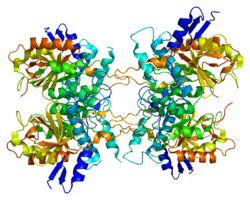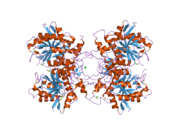ATG4A
| View/Edit Human | View/Edit Mouse |
Cysteine protease ATG4A is an enzyme that in humans is encoded by the ATG4A gene.[3][4][5]
Autophagy is the process by which endogenous proteins and damaged organelles are destroyed intracellularly. Autophagy is postulated to be essential for cell homeostasis and cell remodelling during differentiation, metamorphosis, non-apoptotic cell death, and aging. Reduced levels of autophagy have been described in some malignant tumors, and a role for autophagy in controlling the unregulated cell growth linked to cancer has been proposed. This gene encodes a member of the autophagin protein family. The encoded protein is also designated as a member of the C-54 family of cysteine proteases. Transcript variants that encode distinct isoforms have been identified.[5]
References
- ↑ "Human PubMed Reference:".
- ↑ "Mouse PubMed Reference:".
- ↑ Marino G, Uria JA, Puente XS, Quesada V, Bordallo J, Lopez-Otin C (Feb 2003). "Human autophagins, a family of cysteine proteinases potentially implicated in cell degradation by autophagy". J Biol Chem. 278 (6): 3671–8. doi:10.1074/jbc.M208247200. PMID 12446702.
- ↑ Scherz-Shouval R, Sagiv Y, Shorer H, Elazar Z (Apr 2003). "The COOH terminus of GATE-16, an intra-Golgi transport modulator, is cleaved by the human cysteine protease HsApg4A". J Biol Chem. 278 (16): 14053–8. doi:10.1074/jbc.M212108200. PMID 12473658.
- 1 2 "Entrez Gene: ATG4A ATG4 autophagy related 4 homolog A (S. cerevisiae)".
Further reading
- Scherz-Shouval R, Shvets E, Fass E, et al. (2007). "Reactive oxygen species are essential for autophagy and specifically regulate the activity of Atg4.". EMBO J. 26 (7): 1749–60. doi:10.1038/sj.emboj.7601623. PMC 1847657
 . PMID 17347651.
. PMID 17347651. - Ross MT, Grafham DV, Coffey AJ, et al. (2005). "The DNA sequence of the human X chromosome.". Nature. 434 (7031): 325–37. doi:10.1038/nature03440. PMC 2665286
 . PMID 15772651.
. PMID 15772651. - Gerhard DS, Wagner L, Feingold EA, et al. (2004). "The status, quality, and expansion of the NIH full-length cDNA project: the Mammalian Gene Collection (MGC).". Genome Res. 14 (10B): 2121–7. doi:10.1101/gr.2596504. PMC 528928
 . PMID 15489334.
. PMID 15489334. - Kabeya Y, Mizushima N, Yamamoto A, et al. (2005). "LC3, GABARAP and GATE16 localize to autophagosomal membrane depending on form-II formation.". J. Cell. Sci. 117 (Pt 13): 2805–12. doi:10.1242/jcs.01131. PMID 15169837.
- Ota T, Suzuki Y, Nishikawa T, et al. (2004). "Complete sequencing and characterization of 21,243 full-length human cDNAs.". Nat. Genet. 36 (1): 40–5. doi:10.1038/ng1285. PMID 14702039.
- Strausberg RL, Feingold EA, Grouse LH, et al. (2003). "Generation and initial analysis of more than 15,000 full-length human and mouse cDNA sequences.". Proc. Natl. Acad. Sci. U.S.A. 99 (26): 16899–903. doi:10.1073/pnas.242603899. PMC 139241
 . PMID 12477932.
. PMID 12477932.


